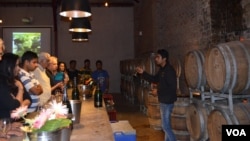Although whiskey remains the top choice for most Indians when they reach for an alcoholic drink, the country is gradually acquiring a taste for wine. India's first vineyard began operations 15 years ago, and since then the domestic wine industry has grown rapidly.
Software engineer Nagesh Kamble and his wife Snehal have come to the rolling, green Sula vineyards in Nashik from Pune in western India to take a first-hand look at how wine is produced. The young couple took to drinking wine on special occasions two years ago.
"It was in in Pune when there was a wine tasting festival going on, it was the first time we had wine, we liked it, and then we thought of going to the tasting rooms, to look at the vineyards and all," said Nagesh.
"We wanted to explore, like [see] how it is prepared and how it is made. … And it is our anniversary this week, so we are kind of celebrating," said Snehal.
Sula Vineyards – India's largest domestic winemaker – opened a tasting room 10 years ago in the midst of hectares of lush plantations to create a wine culture among people like the Kambles. It is packed on weekends, with about 200,000 visit every year. After touring the vineyards and looking at how red, white and sparkling wines slowly ferment, the mostly young visitors learn about the finer nuances of enjoying a glass of wine.
With middle-class incomes growing and aspirational lifestyles spreading beyond the big cities, the wine industry hopes the market will grow exponentially in a country where total annual wine consumption measures less than a teaspoon per person.
Tens of thousands of middle-class Indians are acquiring a taste for wine in a country where the alcoholic beverage market is still dominated by whiskey and where many have traditionally frowned upon alcohol consumption.
Sula’s vice president, Neeraj Agarwal, is a witness to the transformation that has taken place since the company struggled to sell the first 500 cases of wine it produced in 2000. Last year, Sula sold 600,000 cases.
He believes wine is helping change mindsets about alcoholic beverages.
“In five years, the scenario has completely changed," Agarwal said. "Earlier, talking about alcohol in the open and seeing a woman having a glass of wine in hand was a taboo. Now, it’s wonderful, families coming, sitting together and enjoying. And with the education about wine, these have so many complexities, so many aromas and how you pair it with your cuisine and enjoy it. Things are changing."
Sula visitors like IT professional Akshay Rajguru, who is picking up some wine for his friends, agree.
"It is for good times, that’s it," Rajguru said. "… In India people treat liquor as bad thing, but it’s not that bad. I would say it is in the mind."
Young professionals like Kamble and Rajguru are driving the growth of India’s domestic wine market, which is expanding at 13 percent annually, a faster rate than other alcoholic beverages. Over the last decade, 90 wineries have sprung up across Karnataka and Maharashtra states, where the subtropical climate is favorable for growing wine grapes.
Among those contributing to the surge in wine consumption are middle-class women. They are still a tiny segment of wine drinkers; only about 3 percent of women in India have even one drink a year. But their numbers are growing more than twice as fast as men.
That’s thanks to several factors. The last decade has seen more women join the workforce and have independent incomes. In Delhi, Mumbai, Bangalore and other big cities, it's no longer taboo for women to buy wine or nurse a drink.
Once a week or so, 32-year-old Pallavi Kohli heads out for a drink to a restaurant or a pub.
"I love unwinding with a glass of wine over the weekends, especially when there is no movie to watch, and going out with my friends," said Kohli.
Subhash Arora founded the Delhi Wine Club in 2002. He said 40 percent of its members are women.
"Some of them, they do think it is like soft liquor in a sense, [with a] low alcohol level," Arora said. "It is basically a lifestyle drink anyway. So when they go out to outings and parties, before they would not imbibe alcohol, now they say OK, a glass of wine is fine."
However, the nascent wine culture is still restricted to the country’s main cities, which account for most of India's wine consumption.
Wine companies are now targeting the smaller towns. At Sula, Agarwal said a ban on advertising alcoholic beverages means they have to reach customers at wine and music festivals, fashion shows and other settings.
“We have developed teams all over India, so second-tier cities and three-tier cities, our people are going and reaching to potential customers, giving them the taste of wines, explaining about wines," Agarwald said. There's "still [a] big way to go and big potential is there."









